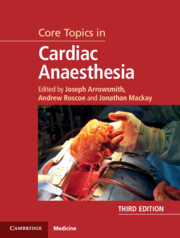Book contents
- Core Topics in Cardiac Anaesthesia
- Core Topics in Cardiac Anaesthesia
- Copyright page
- Dedication
- Contents
- Contributors
- Reviews of the First Edition
- Preface to the Third Edition
- Preface to the First Edition
- Foreword to the First Edition
- Abbreviations
- Section 1 Routine Cardiac Surgery
- Chapter 1 Basic Principles of Cardiac Surgery
- Chapter 2 Symptoms and Signs of Cardiac Disease
- Chapter 3 Diagnostic Techniques
- Chapter 4 Conduct of Anaesthesia
- Chapter 5 Principles of Cardiopulmonary Bypass
- Chapter 6 Weaning from Cardiopulmonary Bypass
- Chapter 7 Routine Early Postoperative Care
- Chapter 8 Common Postoperative Complications
- Section 2 Anaesthesia for Specific Procedures
- Section 3 Cardiac Catheter Laboratory Procedures
- Section 4 Paediatric Cardiac Surgery
- Section 5 Cardiopulmonary Bypass
- Section 6 Advanced Monitoring
- Section 7 Transoesophageal Echocardiography
- Section 8 Miscellaneous Topics
- Index
- References
Chapter 6 - Weaning from Cardiopulmonary Bypass
from Section 1 - Routine Cardiac Surgery
Published online by Cambridge University Press: 12 May 2020
- Core Topics in Cardiac Anaesthesia
- Core Topics in Cardiac Anaesthesia
- Copyright page
- Dedication
- Contents
- Contributors
- Reviews of the First Edition
- Preface to the Third Edition
- Preface to the First Edition
- Foreword to the First Edition
- Abbreviations
- Section 1 Routine Cardiac Surgery
- Chapter 1 Basic Principles of Cardiac Surgery
- Chapter 2 Symptoms and Signs of Cardiac Disease
- Chapter 3 Diagnostic Techniques
- Chapter 4 Conduct of Anaesthesia
- Chapter 5 Principles of Cardiopulmonary Bypass
- Chapter 6 Weaning from Cardiopulmonary Bypass
- Chapter 7 Routine Early Postoperative Care
- Chapter 8 Common Postoperative Complications
- Section 2 Anaesthesia for Specific Procedures
- Section 3 Cardiac Catheter Laboratory Procedures
- Section 4 Paediatric Cardiac Surgery
- Section 5 Cardiopulmonary Bypass
- Section 6 Advanced Monitoring
- Section 7 Transoesophageal Echocardiography
- Section 8 Miscellaneous Topics
- Index
- References
Summary
Failure to wean a patient from CPB at the first attempt after routine cardiac surgery is a relatively uncommon occurrence. Following prolonged, complex or emergency surgery, however, failure to wean is relatively common. In the majority of cases, weaning difficulty can be attributed to myocardial ischaemia secondary to a prolonged AXC time, inadequate myocardial protection, frank MI or coronary embolism. Less common causes include extremes of prosthetic valve malfunction, anastomotic strictures, extremes of vascular resistance and cardiac compression from retained surgical swabs.
- Type
- Chapter
- Information
- Core Topics in Cardiac Anaesthesia , pp. 45 - 49Publisher: Cambridge University PressPrint publication year: 2020



